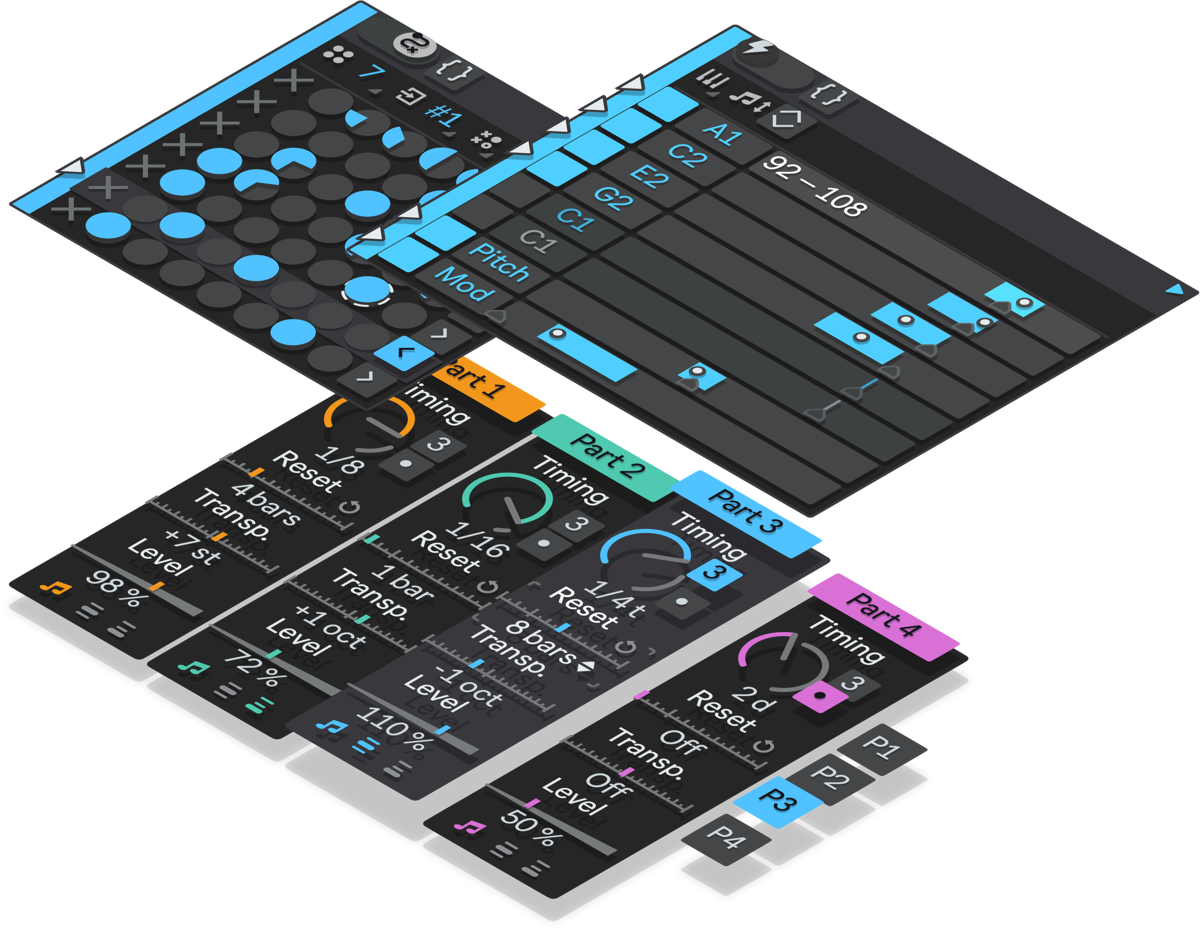Innovative generative music sequencer
Flow is a generative, non-linear MIDI sequencer for Ableton Live that allows you to compose music by defining simple steps and rules that determine how the music will change over time, and cause more complex behaviors and patterns to emerge.
You define the rules, and Flow executes them, producing infinitely long and varying musical patterns.

Flow offers a new way of making music that is based on generative and organic principles, and that lets you explore new possibilities beyond the conventional approaches of linear sequencing.
Algorithmic music composition made easy
Flow draws its power from the concept of a parallel hierarchical probabilistic state machine.
What the heck does that mean? Let's break it down.

State machines
Flow is based on a simple but powerful idea: a state machine. Think of it like a musical heart that pumps out beats and melodies. You can define trigger states that contain musical notes or modulation values, and configure transitions between these states — as opposed to arranging musical events on a fixed grid.
Start from shaping simple rules like these:
- A G chord is followed by an Am chord.
- A loud hi-hat note is followed by a soft note, which is followed by loud, and so on.
- A C note is followed by a G, then a D#, then a D to make an arpeggio.
This concept will free you from the limitations of linear sequencing, such as fixed patterns, rigid structures, and repetitive loops — and the real fun is just getting started!
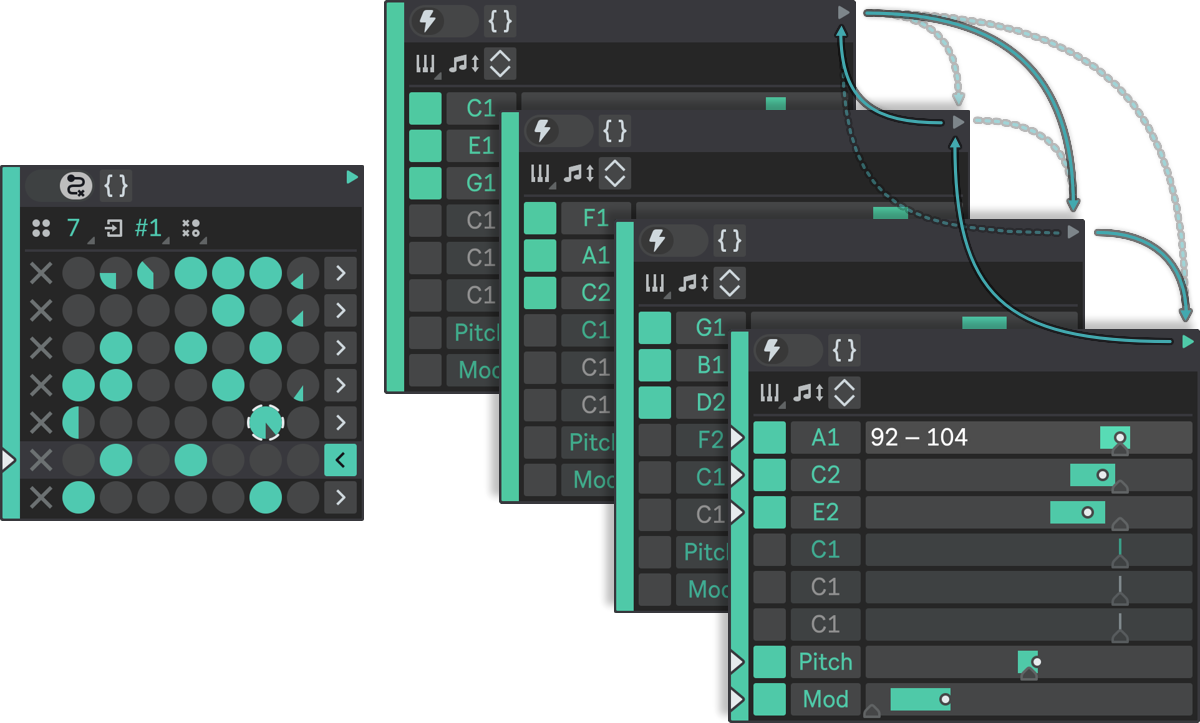
Probabilism
Probabilistic nature allows Flow to vary its behavior from totally predictable to completely random. It can produce sequences as wild or as chill as you want them to be — just spice up those basic rules with a pinch of unpredictability:
- The G chord is usually followed by the Am chord, but sometimes, it may be followed by the C chord.
- Alternating closed hi-hats are sometimes followed by an open hi-hat to add variation to the beat.
- The first note of the arpeggio is occasionally repeated, causing it to continue playing on a different rhythmic subdivision.
Using probabilistic rules, you can create patterns that evolve in stochastic and nonlinear ways, generating complex and constantly varying results.
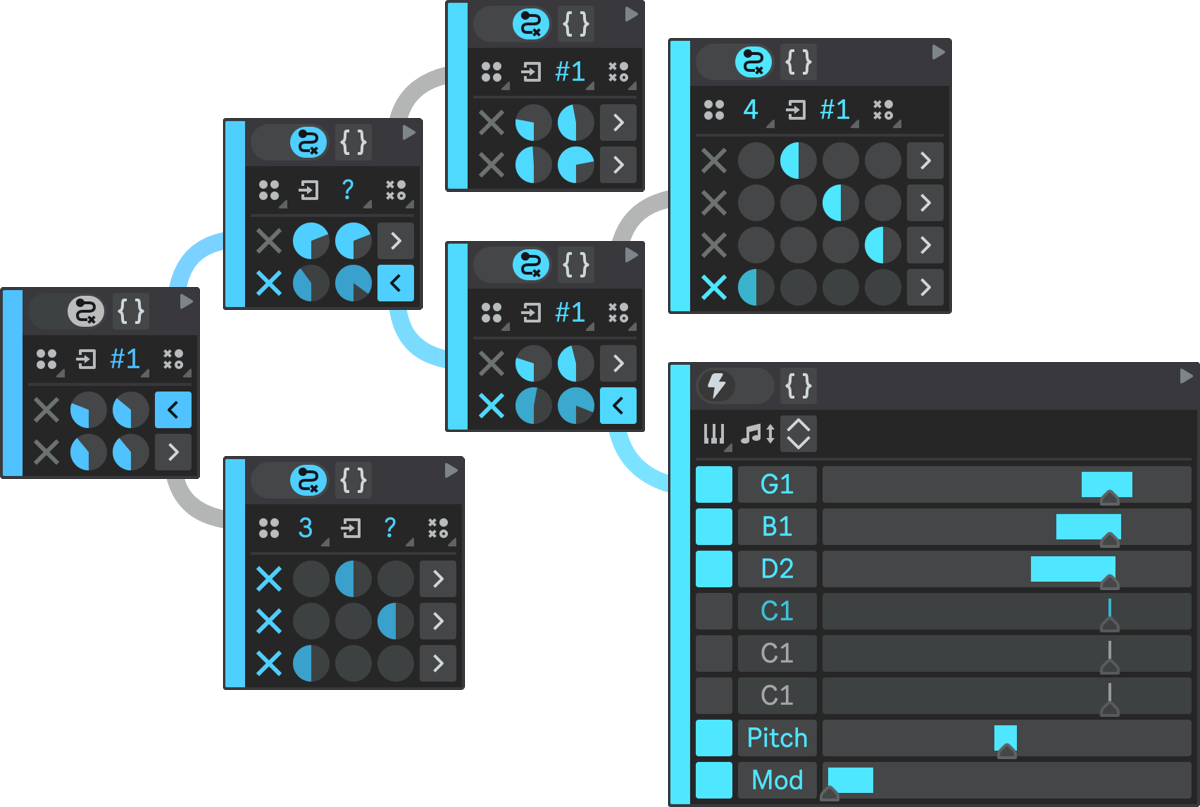
Hierarchical structure
Flow allows you to organize state machines in a hierarchical manner, making them much more powerful and capable of producing even more sophisticated behavior, with multiple levels of detail and variation:
- Play an A minor scale melody and then modulate to the D minor scale.
- Begin by playing the hi-hats, and then transition to playing the ride cymbal or other cymbals.
- Play a C major arpeggio first, followed by either an F major or a G7 dominant arpeggio.
Grouping simple rules together into hierarchical structures allows you to create sequences of arbitrary length and complexity.
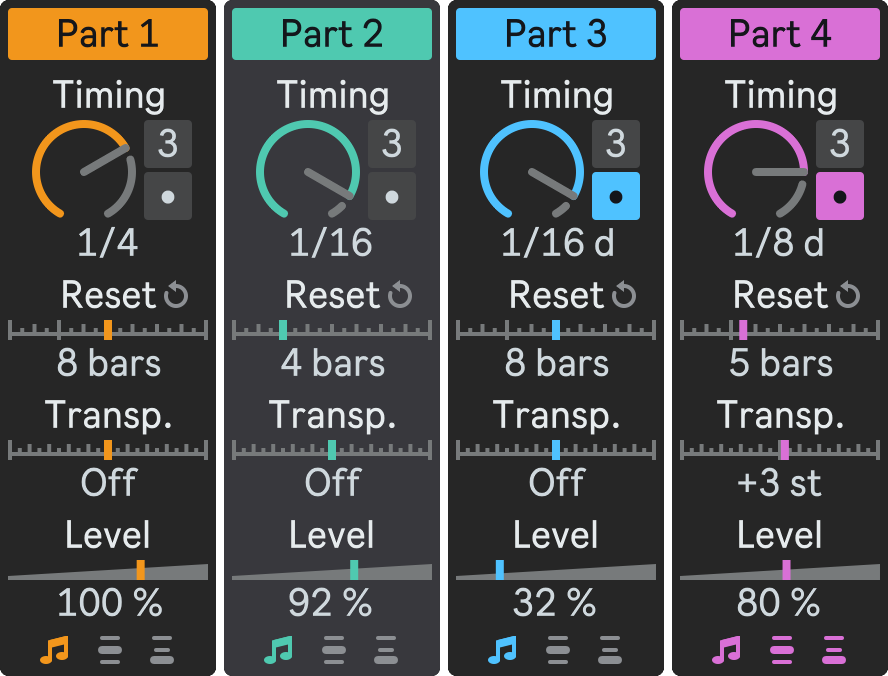
Parallelism
Flow takes it up a notch with four parallel independent sequencer parts that can run simultaneously. This means you can split your patterns into polyrhythmic sections that behave independently and complement each other:
- Play a drum beat with a static eighth note kick and snare pattern to set the base rhythm; do some alternating sixteenth hi-hats or cymbals in parallel; add some groove and variability by playing occasional kick and snare ghost notes.
- Play a chord sequence, arpeggio and melody simultaneously; produce some random modulation changes every once in a while.
- Go wild and do everything at once: rhythmic, harmonic and melodic sequences all together, with additional layer of modulation values.
With parallel sequencer parts, you can design musical structures that interact and harmonize with each other in various ways, creating intriguing rhythms and rich harmonic textures.
Don't take our word for it — hear it for yourself
Check out some examples of music that Flow can produce, using different musical elements, such as rhythm, harmony, melody, and modulation.
This example demonstrates how Flow can generate a complex and dynamic drum beat using different parts of the kit.
The drum beat consists of four parts that work together to create a rich and varied rhythm:
Part 1 lays down the basic rhythm with the kick and snare.
Part 2 adds some variation with the hi-hats (both open and closed), and occasionally switches to a cymbal for emphasis.
Part 3 and Part 4 enhance the beat with some subtle kick and snare notes.
Here, Flow creates a musical pattern with different roles for each part. The generative drums pattern starts later to show how two Flow instances sound together.
Part 1 plays a sequence of chords that defines the tonality and mood.
Part 2 produces an arpeggio that plays on top of the chord progression and adds rhythm.
Part 3 plays a subtle melody.
Part 4 produces modulation values that affect the sound of the notes.
In this example, Flow generates a breakcore-style sound by playing sixteenth notes over a chopped-up version of the famous Amen break.
Part 1 generates notes that follow a different sequence than the original sample, but they are not entirely random neither. They have some variations that make it sound more complex and dynamic.
Part 2 and Part 3 generate some extra pitch and modulation values, which are mapped to Ableton Live's Redux audio effect to produce a glitchy and distorted sound every now and then.
The whole is something besides the parts
Flow offers a new way of making music that is generative, dynamic and unpredictable; music that is inspired by your preferences and tastes, but also challenges you with new possibilities and surprises.
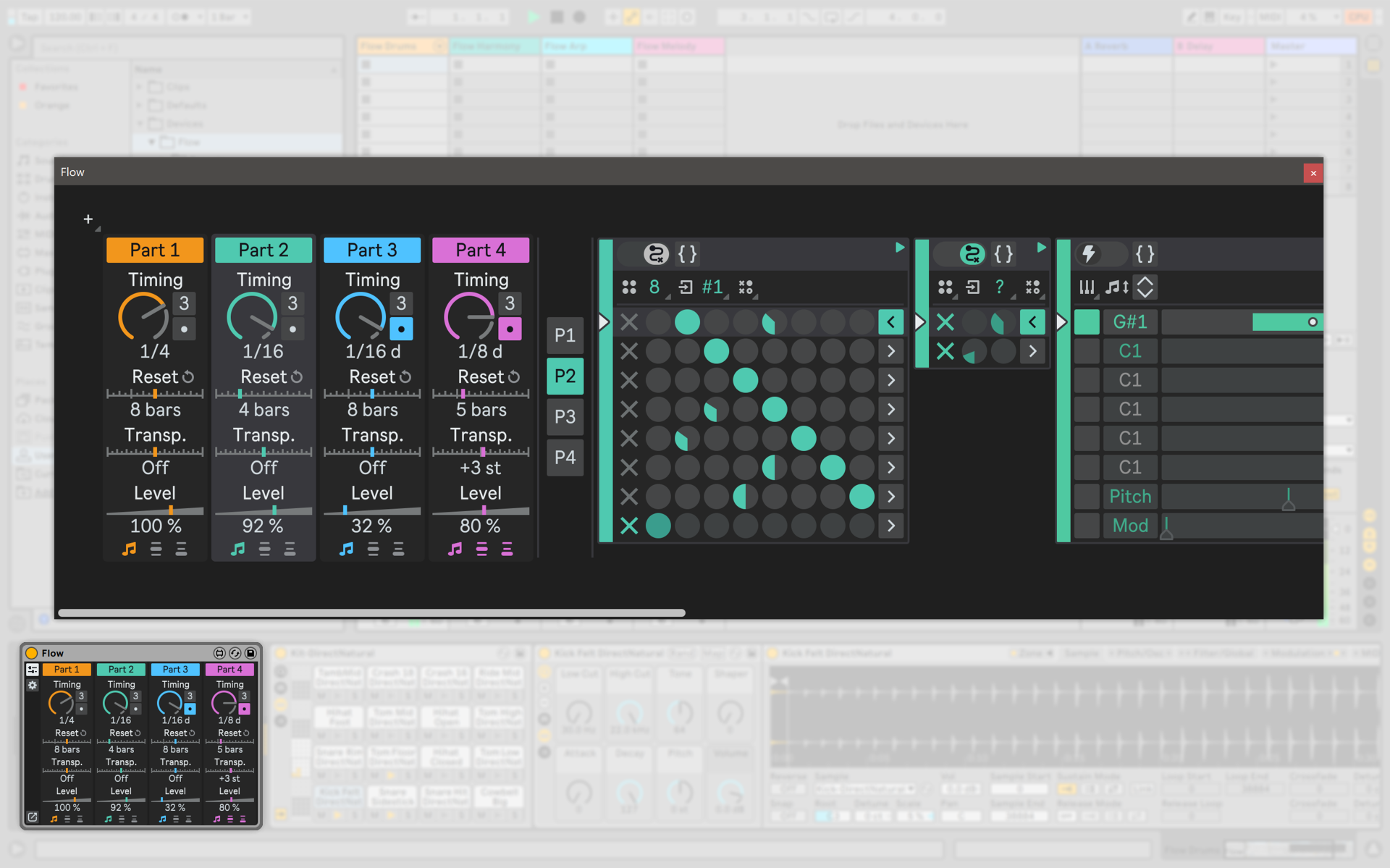
Algorithmic Composition
Generate music that follows your musical vision and intention, by defining the steps and rules that determine how the music will change over time.
Experimentation
Experiment with different musical elements, such as harmony, melody and rhythm, and see how they interact and create musical patterns; explore new possibilities of musical expression, creativity and experimentation.
Inspiration
Use Flow as a source of inspiration and material for your compositions; incorporate the best parts in your pieces, and let it handle some of the creative work for you.
Sound Design
Work on the sonic aspects of your music, while Flow generates music that won't repeat. Focus on the sound design without getting bored by the same loop playing over and over again.
Entertainment
Feel enjoyment and satisfaction by seeing and hearing generative music unfold in real-time, knowing that it's you who invented the rules behind this music.
Live Performance
Make your live performances unique and never repeating. Change the rules and parameters of the music while you perform, to create a dynamic musical experience for yourself and your audience.
Requirements
Minimum
- Windows 7, Windows 8, or Windows 10 / macOS El Capitan 10.11.6
- Ableton Live Suite 10.1+
- 64-bit Intel® Core™ i5 or AMD multi-core processor / Apple silicon
- 4 GB RAM
- 1280x720 display resolution
Recommended
- Windows 10 (Build 1909 and later), Windows 11 / macOS High Sierra 10.13 to Ventura 13
- Ableton Live Suite 11+
- 64-bit Intel® Core™ i5 or AMD multi-core processor / Apple silicon
- 8 GB RAM
- 1920x1080 display resolution
Flow is yours for €49 (excl. VAT)
One-time payment, free lifetime updates.
Ready to dive deeper?
Check out the documentation
Learn more about Flow's unique approach to generative music, find out how it works and what you can do with it.
